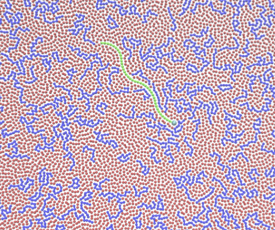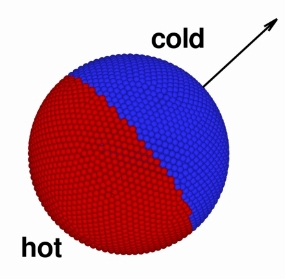Microswimmers
Microswimmers are small particles at the microscale which are able to self-propel in a fluid. There exist biological (e.g. sperm, bacteria) and artificial (e.g. active colloids) microswimmers, which may propel by various driving mechanisms, for example, by using a beating flagella or in response to concentration or temperature gradients. Our research focuses on understanding the complex dynamics of single microswimmers as well as their collective behavior, since they may be used to perform various tasks such as cargo delivery.
Swimming in a viscoelastic medium

The propulsion of various biological and artificial microswimmers through a viscous fluid has received enormous attention recently, including studies on propulsion mechanisms, different swimmer geometries and structures, swimming efficiency, and collective behavior. However, there is a growing interest in microswimmer propulsion through a viscoelastic fluid, since many microswimmers have to propel through non-Newtonian fluids (e.g. sperm in a reproductive tract). We investigate numerically the propulsion of microswimmers through different viscoelastic fluids, in order to identify the effects of fluid elasticity on the swimming pattern, swimming speed, and swimming efficiency in a bulk fluid as well as near a wall. This knowledge is valuable for understanding the propulsion mechanisms of microswimmers in viscoelastic fluids, and for a better design and control of artificial microswimmers.
Thermophoretic microswimmers

Thermophoretic microswimmers are particles which self-propel in temperature gradients through a phenomena called thermophoresis. Temperature gradients can be imposed globally in a fluid or locally on the particle scale. As an example, colloidal particles half-coated with gold can swim in its own local temperature gradient, created by a laser light since the gold cap absorbs heat. The propulsion velocity of thermophoretic swimmers depends on the strength of a temperature gradient as well as on the interactions between the fluid and microswimmer's surface. We investigate the propulsion efficiency of thermophoretic microswimmers depending on local temperature gradients and the interactions at fluid-solid interface. We also study the behavior of such microswimmers near solid surfaces and in binary mixtures, where the fluid composition can be controlled. Finally, we are interested in the collective behavior of thermophoretic microswimmers.
- D. A. Fedosov, A. Sengupta, and G. Gompper, "Effect of fluid-colloid interactions on the mobility of a thermophoretic microswimmer in non-ideal fluids", Soft Matter, 11, 6703-6715, 2015.